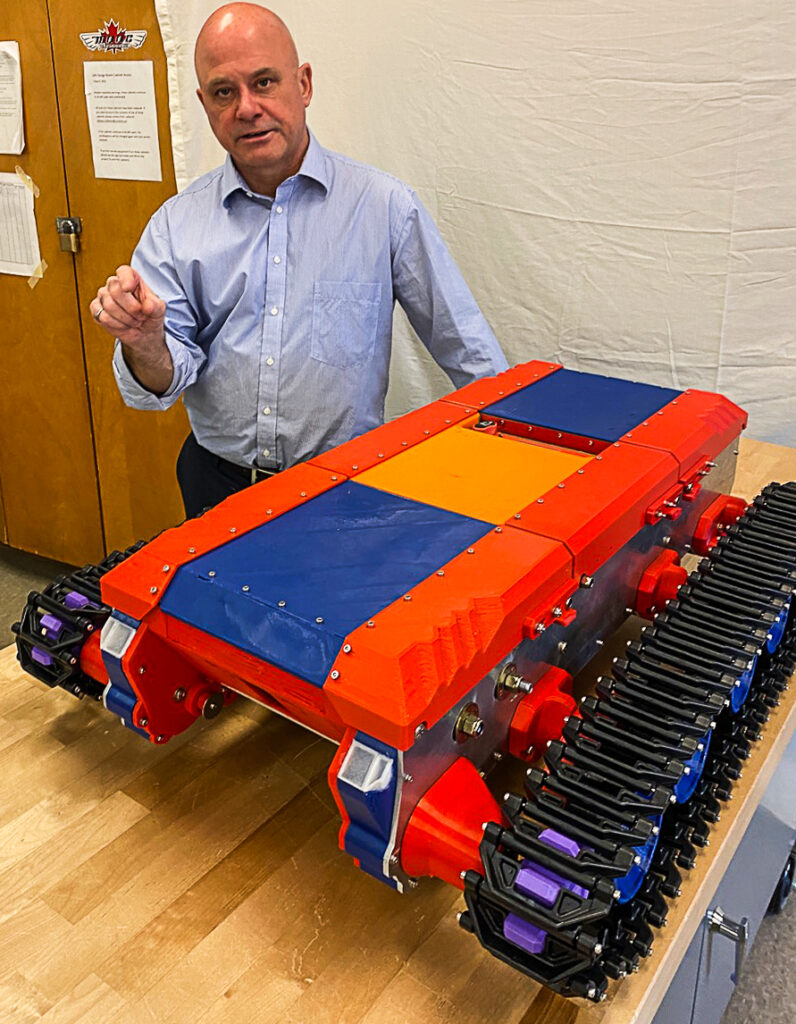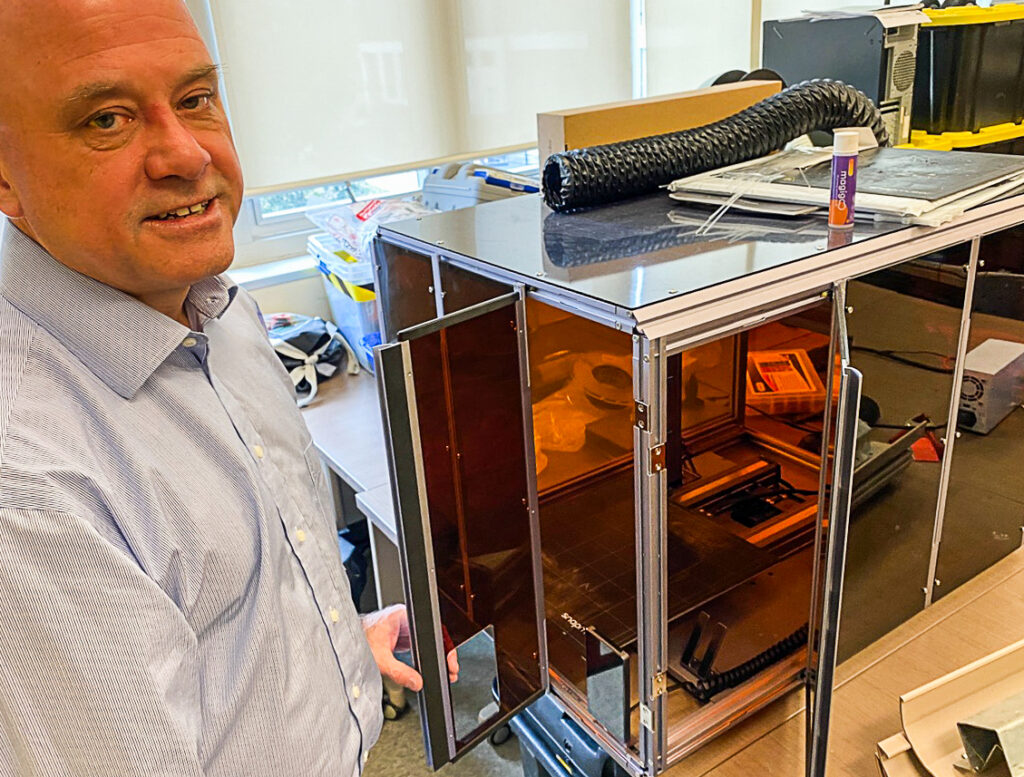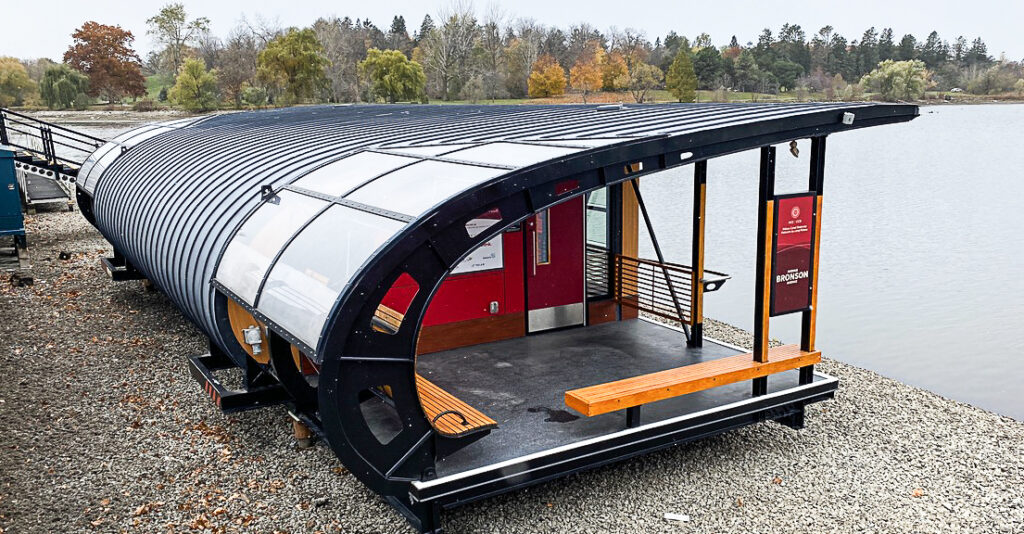
Jack Hanna
The future of the Rideau Canal Skateway is snow-bots.
In the struggle to save the beloved skateway from climate change, small tracked robotic machines may be what rolls to the rescue.
Snow-bots are very lightweight – compared to conventional snowplows and other equipment driven by human operators – so they can get onto canal ice when it is thin and start ice-building much earlier in the season.
A small model snow-bot has been built at Carleton University and will be blowing snow off Dow’s Lake this winter.

Carleton professor Shawn Kenny will be watching the experiment from shore, wearing a skin-diver’s dry suit. He’ll be decked out in neoprene because he expects that, during the experimental stage, the snow-bot will break through the ice and go to the bottom. It will be Kenny who has to enter the frigid water to pull it out.
Kenny, a professor of geomechanics, leads a team of Carleton researchers which is in the middle of a four-year project to help save the canal skateway from a warming climate.
The skateway will need all the help it can get. A 2020 study of how climate change will impact Ottawa in particular predicts winter will be about a month shorter by the 2050s, and there will be more mid-winter thaws and rainfall – all bad news for skaters.
The Carleton research team has reached one big conclusion: once winter has well and truly arrived, there is nothing they can do to mitigate the damage a thaw or a rain storm will do to the canal’s ice surface.
“If it is not going to stay cold,” says Kenny, “we can’t do anything about it.”
But technology does have one role to play; the researchers believe it can let NCC crews get an early start on building ice, so the skateway can open earlier.
“We can work on the ice cover early in the season, get an early start.”
Right now, the NCC uses trucks and tractors with plows, sweepers and snowblowers, as well as a big zamboni. These vehicles weigh tonnes.
Ice-building from the canal banks
The Carleton research team is experimenting with innovative technologies to permit ice-building to get underway while the ice sheet still is too thin to hold human crews and heavy equipment.
For example, from the land on the edge of the canal, snow fans, akin to those used on ski hills, can shoot a mist of water vapour and air out across the ice surface. When the misty mixture lands, it freezes into a new layer of canal ice. In essence, the canal can be flooded before humans can set foot on it.
The snow fans were trialed last winter near Laurier Avenue, and were a success.
“I was pleasantly surprised,” says Kenny. “I didn’t expect it to work as well as it did.”
Snowclearing without heavy plows
Snow-bots are another part of the start-early strategy, especially snow-blower snow-bots.
Cold air coming in contact with an ice sheet causes new ice to form on the bottom of the sheet. But if cold air cannot get to the ice, there is no growth in the ice sheet.
When there is a blanket of snow atop the ice, it insulates the ice from the cold air. Ice building stalls.
Indeed, it was unusually early and heavy snowfall last winter that doomed the skateway to not open at all. It was the first time in the skateway’s 52-year history it failed to open.
Last winter, there was 67 percent more snow than the 30-year average. And the snowfall started early, when the canal ice was too thin to support snowplows. The result: the snow blanket stayed in place, providing an insulating cover. The ice sheet did not thicken.
“The heavy snowfall played havoc,” says Kenny. “I never expected snowfall could be that big a problem and actually cause the cancellation of the whole skating season.”
The snow-bots will be remotely controlled, by either a human or computer operator on the shore.
Their big role will be to blow away snow, so the ice sheet is exposed to cold air.
However, a thin layer of snow, a couple of centimetres thick, can be packed down and flooded. Thus, there might be packer snow-bots. After they pack the snow layer, snow fans can flood it.
There also might be snow-bots that drill holes through the ice sheet. These would be useful if the canal ice sheet is being pressed downwards by the weight of heavy snowbanks along the sides. In that situation, a snow-bot drills holes and canal water flows up and out the holes, naturally flooding the skateway.
And finally, a snow-bot might be equipped with ground-penetrating radar. This would give ice-making crews a picture of the thickness and nature of the snow cover and ice sheet.
The ice fans and snow-bots will only come into play in early winter. Once the ice sheet is sufficiently thick to support normal ice-making operations, the snow-bots are no longer needed.

Building the bots from scratch
The Carleton research team could not find suitable snow-bots on the market. They had to acquire a 3-D printer to make components and build their own machines.
They have started with a reduced-scale model, about a metre long and the weight of a human.
The researchers will experiment to learn how big and weighty the snow-bots need to be. At most, they would be the size of a golf cart.

A longstanding NCC quest to save the skateway
The current research is the most recent chapter in the NCC’s quest to save the skateway’s season from climate change.
In the earliest years of the skateway, says NCC senior manager Bruce Devine, “we waited for the ice to build naturally.” A couple of decades ago, he says, “we noticed the weather was getting warmer over time, so we started to find ways to build ice faster by flooding the snow.”
In recent years, the NCC has rerouted the outflow from 18 storm-sewer drains that empty into the canal. The outflow holds road salt and is relatively warm – and so is bad for ice formation. The NCC has attached pipes to the drains. The pipes dribble the outflow into the canal’s waters, diffusing it.
A more erratic skating season
Climate change is going to continue, so the skateway will be even more imperiled in future. Kenny says that, in the years ahead, the skating season will be “more erratic.”
Looking a couple of decades down the road, new technologies might be introduced, for instance, heat pumps to remove warmth from the water below the ice.
But in the end, technology can play only a minor role.
“Fundamentally, this is not about technology,” says Kenny. “It is about the climate scenario that plays out in future.”
More on this topic: What climate change could mean for winter in Ottawa

2 comments for “Researchers finding new ways to build ice and keep the canal skateway open”